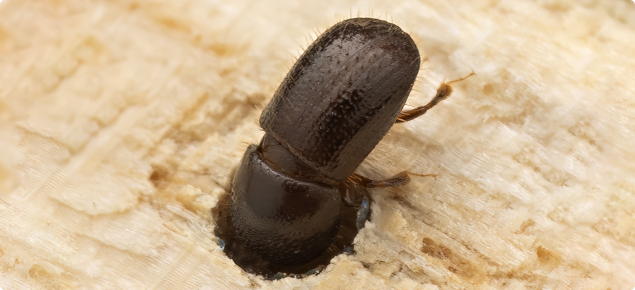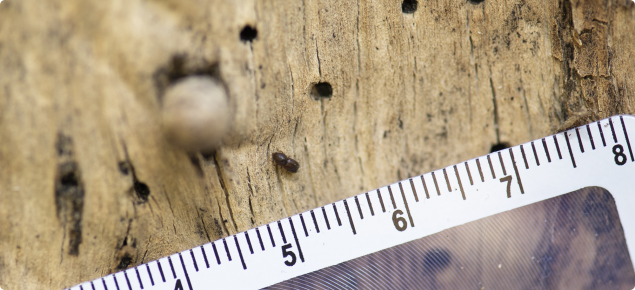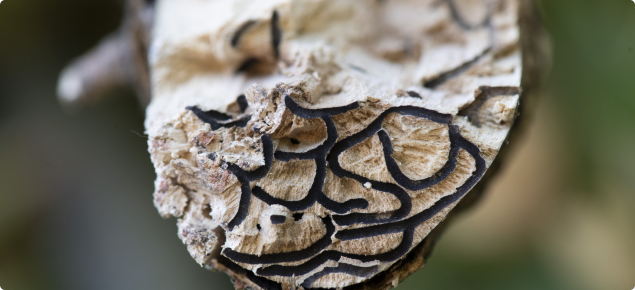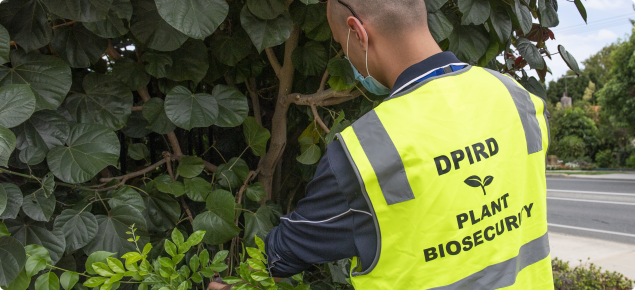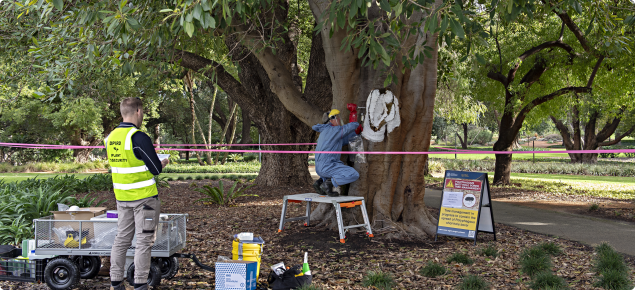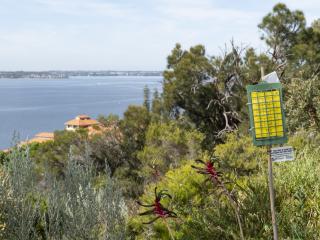About PSHB
PSHB are tree-boring beetles that have a symbiotic relationship with a Fusarium fungus, which it cultivates inside the tree as a food source for themselves and their larvae.
In susceptible trees, the fungus kills the tree by restricting or preventing the movement of water and nutrients within the tree. This causes symptoms such as Fusarium dieback and eventually tree death. The beetle also causes structural damage in the tree.
Establishment of this pest in WA would have a significant impact on our urban canopy and possibly threaten our agricultural industry. Underway since 2021, the PSHB eradication program is a nationally coordinated and funded eradication response led by DPIRD.
Current Situation
As of September 2024, PSHB has only been found in the Perth metropolitan area. Intensive surveillance and management activities underway across the metropolitan area include:
- Surveillance to determine the distribution of PSHB.
- Containing the pest to prevent further spread to non-infested regions within Western Australia.
- Removing infested trees to eradicate the beetle and save healthy trees.
- Providing advice and information to residents, industry and other stakeholders.
- Ensuring all response activities are conducted safely, consistently and efficiently.
In addition to the Perth based surveillance, DPIRD has deployed PSHB surveillance traps in multiple regional areas including Harvey, Mt Barker, Manjimup and Bunbury. Those traps have not returned any positive PSHB detections.
Report suspect PSHB infestations to DPIRD through PaDIS or on the MyPestGuide Reporter App (See below for details)
Keep an eye out
Detection of PSHB is difficult as they are very small – about the size of a sesame seed. However, there are a number of symptoms that indicate a tree may be infested.
Watch the animation below on YouTube to learn more and find out how to report PSHB sightings.
Quarantine Area (QA)
A Quarantine Area Notice (QAN) restricting the movement of wood and plant material has been put in place to help stop the spread of PSHB.
The QA was extended on 6 September 2024 to cover the entire Perth Metropolitan area, extending across 30 local government areas.
The QA encompasses two zones.
- Zone A covers an area with high numbers of infested trees and where intensive control activities such as tree removal are underway. This zone will have more restrictions on the movement of high-risk materials.
- Zone B covers an area with fewer or no infested trees and where heightened surveillance is underway to identify and control new infestations. This zone will help create a buffer between areas of high infestations and the rest of WA, further protecting WA’s growing areas.
You can enter your address into the interactive map below to see if your residence is in one of these zones.
Residents in Zone A:
- cannot move untreated or unseasoned wood outside Zone A, unless chipped to pieces that are 2.5 cm or less in diameter,
- cannot move plant materials, including living plants, that are greater than 2 cm in diameter outside Zone A,
- must ensure any machinery used to handle green waste is cleaned before it can be moved outside Zone A.
Residents in Zone B:
- cannot move untreated or unseasoned wood outside the Quarantine Area, unless chipped to pieces that are 2.5 cm or less in diameter,
- cannot move plant materials, including living plants, that are greater than 2cm in diameter outside the Quarantine Area,
- can move wood or plant materials, including living plants, into Zone A,
- must ensure any machinery used to handle green waste is cleaned before it can be moved outside the Quarantine Area.
The above restrictions do not apply to grass and lawn clippings as these materials do not host the beetle.
Anyone that cannot meet any of the above requirements must contact DPIRD for a permit before moving restricted materials.
Wood refers to wood that is not treated. Treated or seasoned (> 6 months) timber or wood products that are in use for construction, fencing, furniture or packaging and pallets are not considered to be wood and are therefore not considered to be PSHB risk material.
The borer does not affect grass or foliage. Lawn clippings and leaf like material can be disposed of as normal.
Living plants refers to any plant, organ or plant part (including plant cuttings) with woody stems that are greater than 2 cm in diameter.
Wood machinery means any vehicle, equipment or other mechanical apparatus of any kind that has been used in relation to arboriculture, wood mulching, wood chipping or handling of any other wood.
Applying for a permit
A permit and inspection are required if the conditions of the Quarantine Area Notice cannot be met.
For example, if you purchase a mature tree (woody stems greater than 2 cm diameter) from a nursery within the QA and wish to move the tree to your property outside the QA, a permit is required before you move the tree. This is to clear the plant of any signs or symptoms of PSHB and to track movement of plants outside the QA.
To apply for a permit or to arrange an inspection please email PSHB@dpird.wa.gov.au. or call the Pest and Disease Information Service on 9368 3080.
Trapping
DPIRD is conducting trapping and surveillance to determine and monitor the spread of the pest. Traps are being distributed throughout the QA, across the metro area as well as outlying suburbs of the QA. These traps will remain in place for at least six months and help monitor the distribution of PSHB
Traps contain a yellow sticky trap in a cage (to prevent trapping birds, micro bats, rodents etc) with a lure. The lures contain Querciverol, an aggregation pheromone that attracts PSHB beetles.
If you see a trap, don't touch them! They have a very important job to do.
What plants are affected?
PSHB causes serious damage to many types of trees and plants. However it is particularly drawn to Box Elder Maples (Acer negundo). We are asking people who have a box elder maple on their property or who identify one on the street or any public areas, that you report the location of these trees. This is crucial so we can inspect the trees determine if they are infested with PSHB or have a high probability of becoming infested.
Reproductive hosts are susceptible trees in which both the beetle and the fungus successfully establish and reproduce. The global host list is extensive, with over 100 reproductive hosts. The top hosts are:
- Maple (Acer)
- Black locust (Robinia)
- Coral tree (Erythrina)
- Plane tree (Platanus)
- Fig (Ficus)
- Poinciana (Delonix)
- Mirror bush (Coprosma)
- Castor oil (Ricinus)
Non-reproductive hosts are plants that can be attacked by the beetle however, PSHB is not reported to be able to successfully establish galleries and complete their lifecycle in these species.
While the fungus may be present in these hosts the disease does not establish and these hosts are not expected to die. Pruning of these hosts of the affected areas are possible, to be able to save the plant. Non-reproductive hosts include citrus (Citrus) and grapes (Vitis).
What do I look for?
Detection of PSHB is difficult as they are very small – about the size of a sesame seed. Female PSHB are approximately 2 mm in length and range from brown to black in colour. Only the females can fly and disperse to other nearby trees. Males are smaller at approximately 1.6 mm in length and have no wings.
Mature larvae are approximately 3.5 mm long and 1.1 mm wide. They are white, ‘C’ shaped and legless with a reddish head.
However, there are several symptoms that indicate a tree may be infested. These include:
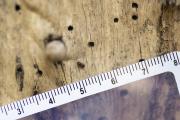 Beetle entry holeThe entrance holes of PSHB are approximately the size of the tip of a ballpoint pen tip. |
 Discolouration or staining of woodThe Fusarium fungus cultivated by the beetle can cause dark discolouration.You will see this in the galleries they create and sometime on the outside of the tree running from the shothole. |
 GummingGumming is a thick resin or sap produced by the tree in response to the beetle boring in. This gumming sometimes pushes the beetle out of the gallery. |
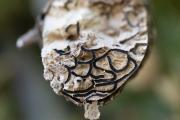 "Galleries"PSHB create intricate tunnels or galleries where they farm fungus as a food source |
FrassSimilar to sawdust, frass is produced by the beetle's tunnelling. The presence of frass or "noodles" extruding from trees can indicate a high level of infestation. |
 DiebackIn susceptible trees the Fusarium fungus occludes trees’ vascular tissue, so preventing transport of water and nutrients and eventually causing branch dieback and tree death. An infested tree will start to lose its leaves and the branches will slowly die back. |
How does the pest and its symbiotic fungus survive and spread?
Native to Southeast Asia, PSHB has spread to countries including Israel, the USA South Africa and Argentina. The pest is now here in WA.
It is possible PSHB “hitchhiked” its way to Australia on untreated wooden articles and packaging materials. Subsequent spread can be aided by the movement of infested wood (such as pruned trees, firewood) or wooden products such as furniture.
Management of infested trees
PSHB can severely damage host trees by excavating tunnels in trees in which they cultivate the Fusarium fungus. This fungus occludes the vascular system of the host tree preventing the transport of water and nutrients, as a consequence of which some trees can die within a period of two years. Trees infested by PSHB can quickly become public safety hazards and a constant source of beetles that can disperse to neighbouring trees, causing spread.
DPIRD recognises the significant value of trees to individuals and the community. Unfortunately, pruning or removal of infested trees is a necessity when it comes to stopping the spread and eradicating the beetle. Removing infected trees will help save many other healthy trees.
Unfortunately, there are currently no effective chemical treatments for PSHB as the Fusarium fungus prevents systemic insecticides and fungicides from reaching the borers. Further, surface application of chemicals is ineffective as PSHB spends most of their lives inside the host tree.
DPIRD is working with local councils, other government agencies and residents in the Perth metropolitan area to respond to detections of PSHB as part of a nationally co-ordinated response.
Contact DPIRD for advice regarding treatments or tree removal. Incorrect treatments can cause further damage to the tree and can aid in the spread of PSHB
A direction to remove an infested tree will only come via DPIRD following the issue of a Pest Control Notice (PCN).
Actions to minimise spread
Early detection
- Monitor susceptible species including your local street and park trees for signs of PSHB damage and report any suspicious infestation signs to DPIRD.
- Speak to your family, friends and neighbours to create awareness.
Firewood - buy it where you burn it
PSHB does not move far on its own but can travel long distances when people unknowingly intervene. Firewood can catalyse and provide a great mechanism for the distribution of PSHB without you knowing.
- Don't move firewood long distances including when you go camping - buy it where you burn it.
- Don't burn wood from host trees, especially if it looks like it has borer damage. PSHB beetles disperse when infested wood is burnt.
Tips for keeping your trees healthy
- Use grass clippings or compost as mulch as possible in your garden as wood chips from non-reputable places can spread PSHB
- While pruning or gardening check your plants and branches for sign of PSHB
- Disinfect pruning tools. Any tools (including chainsaws and woodchippers) that come into contact with infected wood should be sanitised before using on uninfected trees
- Try to avoid moving plants or wood products too far from your local area inside the QA
- Don’t move plants, wood or green waste from a known PSHB infestation area
- Follow the current QA requirements
- Plant native species over exotic plants. See the recommended plant list here
- Don’t take it upon yourself to dispose of a possibly infested plant
- Contact DPIRD regarding any questions or advise
Report suspect PSHB infestation
Please include a ballpoint pen or ruler in photos of bore holes. This assists us in assessing the size of the bore holes.
DPIRD Pest and Disease Information Service
MyPestGuide®

